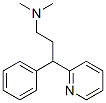
Pheniramine
- Product NamePheniramine
- CAS86-21-5
- CBNumberCB3192278
- MFC16H20N2
- MW240.34
- EINECS201-656-2
- MDL NumberMFCD00865659
- MOL File86-21-5.mol
Chemical Properties
| Melting point | <25 °C |
| Boiling point | bp13 181°; bp2 142°; bp0.5 135° |
| Density | 1.0081 |
| refractive index | nD25 1.5519 to 1.5521 |
| Flash point | 9℃ |
| storage temp. | -20°C |
| solubility | Chloroform (Slightly), DMSO (Slightly), Methanol (Slightly) |
| form | Oil |
| pka | pKa 4.03± 0.08;9.32± 0.06(H2O,t undefined,I=0.30(NaCl)) (Uncertain) |
| color | Colourless |
| InChIKey | IJHNSHDBIRRJRN-UHFFFAOYSA-N |
| CAS DataBase Reference | 86-21-5(CAS DataBase Reference) |
| FDA UNII | 134FM9ZZ6M |
| ATC code | D04AA16,R06AB05 |
| NIST Chemistry Reference | Pyridine, 2[alpha-(2-dimethyl aminoethyl)benzyl](86-21-5) |
| UNSPSC Code | 41116107 |
| NACRES | NA.24 |
Safety
| Symbol(GHS) |
  
|
| Signal word | Danger |
| Hazard statements | H225-H301+H311+H331-H370 |
| Precautionary statements | P210-P260-P280-P301+P310-P311 |
| Hazard Codes | F,T |
| Risk Statements | 11-23/24/25-39/23/24/25 |
| Safety Statements | 16-36/37-45 |
| RIDADR | UN1230 - class 3 - PG 2 - Methanol, solution |
| WGK Germany | 1 |

